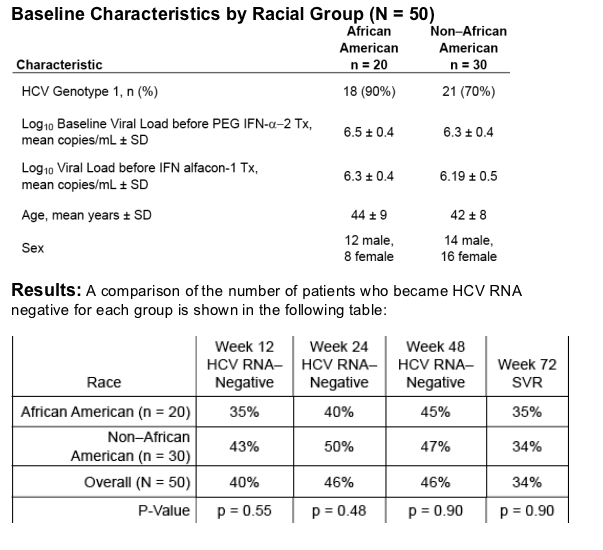 |
 |
 |
| |
Consensus IFN+ IFN Gamma-1b in African-American Peg Nonresponders
|
| |
| |
Reported by Jules Levin
http://www.natap.org
AASLD, Nov 2005, San Francisco
"Comparison of African American and Non–African American Patient Sustained Virologic Response in PEG IFN Alfa-2 +
Weight-Based Ribavirin Nonresponders Re-treated with IFN alfacon-1 + IFN gamma-1b"
Carroll Leevy1, Chris Chalmers2, Lawrence M. Blatt2
1The New Jersey School of Dentistry and Medicine, Newark, NJ
2InterMune, Inc., Brisbane, CA
This study is a retrospective review of patients treated with PEG IFN-_-2 + RBV who had <2 log10 reduction in HCV RNA (nonresponders). Therapy was switched to a combination of IFN alfacon-1 15 _g administered subcutaneously (SC) daily (QD) and IFN-_ 1b 50 _g SC 3x/wk (TIW) for 48 wk. SVR was defined as having undetectable HCV RNA 24 weeks after the last dose. A total of 50 patients were treated: 20 African Americans and 30 non–African Americans.
The combination of IFN alfacon-1 (15 _g QD) + IFN-_ 1b (50 _g TIW) was generally well tolerated in this retrospective review of patients with chronic HCV
Reductions in ANC were well controlled with filgrastim and patients’ hemoglobin levels returned to normal during treatment
34% of the patients (overall) who were nonresponders to PEG IFN-_-2 + RBV achieved an SVR after therapy with IFN alfacon-1 + IFN-_ 1b
African American and non–African American nonresponder patients had a similar rate of on-treatment virologic response and SVR after therapy with IFN alfacon-1 + IFN-_ 1b
Further study is warranted in a larger patient population
ABSTRACT
Background: Therapy for chronic hepatitis C with pegylated interferon alfa-2 plus ribavirin (PEG IFN-_-2 + RBV) results in approximately 50% of patients achieving a sustained virologic response (SVR); however, African American patients have considerably lower SVR rates. Consensus interferon (IFN alfacon-1) is a non-naturally occurring type I IFN that displays 10- to 100-fold higher biological potency when compared with naturally occurring type I IFNs. We have demonstrated that antiviral and immunologic effects are enhanced when IFN alfacon-1 and IFN gamma-1b (IFN-_ 1b) are combined in in vitro systems. We report herein our data on SVR and safety of IFN alfacon-1 and IFN-_ 1b in
African American and non–African American HCV patients who were nonresponders to PEG IFN-_-2 + weight-based RBV (1–1.2 g/day).
Methods: All patients (N = 50) received PEG IFN-_-2 + RBV for 12 wk and
did not achieve ≥2 log10 drop in HCV RNA. With no washout period, patients were re-treated with IFN alfacon-1, 15 _g subcutaneous (SC) daily, and
IFN-_ 1b 50 _g SC 3x/wk for 48 wk. Serum HCV RNA was assessed at Wk 8, 12, 24, 48 (end of treatment), and 72 (SVR) to determine virologic response on and off treatment. Twenty patients (40%) were African American.

One patient interrupted therapy due to constitutional symptoms while all others tolerated therapy well. By Wk 48, 13 patients (26%) required filgrastim for reductions in ANC to below 0.75 x 109/L. After 12 wk of PEG IFN-_-2 + RBV therapy, the mean hemoglobin level was 11.6 ± 0.7 g/dL. By Wk 8 all IFN alfacon-1 and IFN-_ 1b patients recovered hemoglobin levels to normal with
no use of erythropoietin.
Conclusions: African American and non–African American nonresponder patients had a similar rate of on-treatment virologic response and SVR after therapy with IFN alfacon-1 and IFN-_ 1b. The addition of IFN-_ 1b to IFN alfacon-1 in the re-treatment of African American patients who have failed to respond to PEG IFN-_-2 + RBV may emerge as an important treatment option and further study is warranted to confirm these observations.
Safety
Dosing was temporarily interupted for one patient; there were no dosing
reductions for other patients
Neutropenia was manageable with G-CSF and did not require dose reductions. No further details were furnished regarding this on poster.
Hemoglobin levels in all patients returned to within normal range while patients were receiving IFN alfacon-1 and IFN-_ 1b. No erythropoietin was used in this study
Efficacy
- Patients had rapid reduction in ALT after initiation of therapy
- 14 patients (28%) had reductions in WBC (ANC < 0.75 x 109) that required use of G-CSF
BACKGROUND
Combining Type I and II Interferons Holds Promise for the Treatment of Chronic HCV
- Consensus IFN (IFN alfacon-1) is a bioengineered, nonnaturally occurring type I IFN that displays 10- to 100-fold higher biological potency when compared with naturally occurring type I IFNs
- We have demonstrated that antiviral and immunologic effects are enhanced when IFN alfacon-1 and IFN-_ 1b are combined in in vitro systems
- Clearance of acute HCV infection requires a potent IFN-_ response
- Clearance of HCV in chronically infected patients treated with IFN-_ requires a shift from a dominant Th2 to Th1 response (mediated by IFN-_)
- RBV induces the production of Th1 cytokines (e.g., IFN-_)
- IFN-_ reverses HCV core negative effects on STAT phosphorylation
- IFN-_ has its own intrinsic antiviral activity
IFN alfacon-1
- Type I interferon
- Approved for the treatment of HCV
- Binds and signals through type I receptor
- Bioengineered: consists of the most common amino acids in naturally occurring IFN-_ subtypes
- 10- to 100-fold higher biological potency in vitro compared with IFN-_-2b/2a
- Promising data in treatment of PEG IFN-_-2 + RBV nonresponders
IFN-_ 1b
- Type II interferon
- Approved for the treatment of chronic granulomatous disease and osteopetrosis
- Binds and signals through type II receptor
- Has a spectrum of biologic effects:
- Antiviral
- Th1 cytokine
- Antiproliferative
- Immunomodulatory
|
|
| |
| |
|
 |
 |
|
|